Stokowski Society
Circa 2003 -2009
For a number of years this was the Leopold Stokowski Society's website.The society's mission was devoted to the reissue of Stokowski's recordings, performances of his celebrated orchestral transcriptions, and the appreciation of his life and work.
Below is an edited version of the original content from the site's 2003 -2009 archived pages. The new owners of this domain want to keep the legacy of Leopold Stokowski alive on the web so they applied for and obtained a grant from the Web Archive Project. TNG/Earthling's CEO Bob Sakayama provided pro bono technical support while Rev Sale handled research and development.
The current website for the Leopold Stokowski Club (formerly the Leopold Stokowski Society of America, L.S.S.A.) is found at: www.classical.net/music/guide/society/lssa/index.php.

Introduction
Leopold Stokowski (1882-1977) was one of the 20th Century's greatest orchestral conductors. British-born of Polish-Irish ancestry, his musical career was made in the United States, where he became a naturalised American citizen. He built the Philadelphia Orchestra into one of the world's finest orchestral ensembles, championed countless contemporary composers, made hundreds of outstanding recordings, appeared in several motion pictures, and in his later years guest-conducted all over the world to tremendous acclaim. He was still active at the time of his death at the age of 95 in 1977.
Two years later The Leopold Stokowski Society was formed. Its objectives were devoted to the reissue of Stokowski's recordings, performances of his celebrated orchestral transcriptions, and the appreciation of his life and work. The Society published its own magazine, entitled TOCCATA, thee times a year, and in conjunction with Cala Records released historic Stokowski recordings on CD twice a year. However, as will be seen in the News section, after 30 years of highly fruitful activity and existence, for various reasons the Society is closing down at the end of 2009.
~~~~~~~~~~~~~~~~~~~~~~~~~~~~


Born in London in 1882 to a Polish father and an Irish mother, Leopold Stokowski showed an early aptitude for music, entering the Royal College of Music at the age of thirteen. He sang in the choir of St. Marylebone Church, became Assistant Organist to Sir Henry Walford Davies at The Temple Church, and in 1900 formed the choir of St. Mary's, Charing Cross Road. He took his Bachelor of Music Degree at Queen's College, Oxford, became a Fellow of the Royal College of Organists, and in 1902 was appointed Choirmaster at St. James's Church, Piccadilly. In 1905 he took up a similar appointment at St. Bartholomew's, New York City, and it was in America that his career was to flourish.

In 1905 he took up a similar appointment at St. Bartholomew's, New York City, and it was in America that his career was to flourish. He moved from the organ loft to the orchestral podium when he made his concert debuts in Paris and London in 1909, and that same year he was appointed conductor of the Cincinnati Orchestra. Three years later he took over the Philadelphia Orchestra, a position he was to retain for a quarter of a century, during which time he transformed a provincial ensemble into a world class orchestra noted for its precision, virtuosity and tone-colour.
He moved from the organ loft to the orchestral podium when he made his concert debuts in Paris and London in 1909, and that same year he was appointed conductor of the Cincinnati Orchestra. Three years later he took over the Philadelphia Orchestra, a position he was to retain for a quarter of a century, during which time he transformed a provincial ensemble into a world class orchestra noted for its precision, virtuosity and tone-colour. Stokowski championed living composer with hundreds of premieres: he introduced to American audiences Mahler's 8th Symphony, Stravinsky's Rite of Spring,Schoenberg's Gurrelieder, Alban Berg's Wozzeck and many of the works of Richard Strauss, Rachmaninov, Sibelius, Shostakovich, Falla, Prokofiev, and countless American composers.
At the end of the 1930s, Stokowski left Philadelphia to form the All-American Youth Orchestra and co-conduct the NBC Symphony with Toscanini. By this time he had appeared in a few films, notably the 1940 production of Walt Disney's Fantasia. Within a few years he had founded the New York City and Hollywood Bowl Symphony Orchestras, and in the late 1940s he became a chief Guest Conductor with the New York Philharmonic.
From 1951 Stokowski began a new career abroad, making frequent guest appearences with the world's finest orchestras. From 1955-61 he was Music Director of the Houston Symphony Orchestra and in 1962 he founded the American Symphony Orchestra in New York. In 1963 he made his debut at the Sir Henry Wood "Proms" in London - the first 'international' conductor to do so - and his concerts there included a memorable Proms premiere of Mahler's Resurrection Symphony. In 1972 Stokowski returned to England, where he remained until his death, giving many memorable concerts and making recordings almost until the day he died.
David Mellor has written: "One of the great joys of recent years for me has been the reassessment of Leopold Stokowski... Stokowski is now recognized as the father of modern orchestral standards. He possessed a truly magical gift of extracting a burnished sound from both great and second-rank ensembles. He also loved the process of recording and his gramophone career was a constant quest for better recorded sound. But the greatest pleasure of all for me is his acceptance now as an outstanding conductor of nineteenth- and twentieth- century music, including a lot that was at the cutting edge of contemporary achievement."
~~~~~~~~~~~~~~~~~~~~~~~~~~~~~~~~~~~~



STOKOWSKI AND THE NEW YORK PHILHARMONIC!
In the immediate post-war years, Stokowski was invited to become a Guest Conductor with the Philharmonic-Symphony Orchestra of New York, as it was then called. His concerts with the orchestra were a great success: "Mr Stokowski's conducting was pure miracle from beginning to end," wrote Olin Downes in the New York Times,"everything was played with wondrous beauty of sound, with the noblest proportions, with the utmost grandeur of expression."
In 1947-49, Stokowski and the New York Philharmonic made a series of splendidly dramatic recordings for American Columbia. They were issued on 78s and early LPs but most of them remained in the vaults - until now. Under a special arrangement with Sony Music Studios, New York, the Leopold Stokowski Society and Cala Records are proud to announce the release this coming Autumn of 2 volumes (each CD lasting about 77 minutes) of Stokowski's classic NYPSO recordings. The transfers have been taken from the original lacquer sources and reveal superb performances in a much wider dynamic range than was evident on the old 78s and LPs.
The repertoire is as follows:
Wagner The Flying Dutchman Overture
Wotan's Farewell and Magic Fire Music
Ippolitov-Ivanov In the village
Messiaen L'Ascension
Griffes The White Peacock
Vaughan Williams "Greensleeves" Fantasia
Tchaikovsky Francesca da Rimini
Wagner Rienzi Overture
Siegfried's Rhine Journey and Funeral Music
Sibelius Maiden with the Roses
Khachaturian Masquerade Suite
Tchaikovsky Serenade for Strings - Waltz
Schoenberg Song of the Wood-Dove
Copland Billy the Kid - Excerpts
The CD Booklets Notes quote reviews of the original releases, with Stokowski's performances being described as "transparently beautiful," "most exciting," and "a stunning example of the recorder's craft".
Note: Both these colourful CDs will be released simultaneously this Autumn, but Members of the Leopold Stokowski can obtain them at Special Low Prices direct from the factory - several weeks earlier than their retail availability.
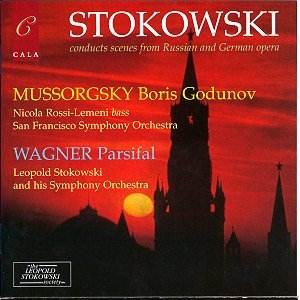
Modest MUSSORGSKY(1839 - 1881)
Boris Godunov, opera in 4 acts(1874) (Suite arr. Stokowski) [51.45]
Nicola Rossi-Lemeni, bass, as Boris and Varlaam
Lawrence Mason, tenor, as the Simpleton; Raymond Cauwet, soprano, as Feodor
San Francisco Opera Chorus, Kurt Herbert Adler, Chorus Director
San Francisco Boys’ Chorus, Madi Bacon, Director
San Francisco Symphony Orchestra/Leopold Stokowski.
Recorded 10 December 1952. First released as RCA Red Seal mono LP LM 1764
Richard WAGNER (1813 - 1883)
Parsifal,A Festival piece in Three Acts (1879)
Good Friday Spell [11.07]
‘Symphonic Synthesis’ of Act III (arr. Stokowski) [16.40]
Leopold Stokowski conducting His Symphony Orchestra
Recorded 24 September 1952. First released as RCA Red Seal LP mono LM 1730
Notes in English. Transliterated Russian and English text. Photo of Rossi-Lemeni.
Recorded locations not given. [ADD]
Sponsored by the Leopold Stokowski Society UK
Comparison Recordings
Boris Godunov ‘Symphonic Synthesis,’ Stokowski, L’Orchestre de la Suisse Romande Decca ‘Phase 4’ E4438962
Boris Godunov (Rimsky-Korsakov edition) Issay Dobrowen, Boris Christoff, bass; (mono) French National Radio Orchestra. EMI 7243 5 65192 2 0
Parsifal excerpts, Stokowski, Houston Symphony Orchestra Everest EVC 9024
Stokowski first conducted Borisin Philadelphia in 1929, drawing the various sections from three published ‘original’ editions of the opera. Subsequently he arranged a 25 minute ‘Symphonic Synthesis’ which was recorded with the Philadelphia Orchestra on 78 rpm disks, and was hailed as a marvel of high fidelity recording at the time with its realistic depiction of bell and percussion sounds. This version was re-recorded in 1968 and released on Decca ‘Phase 4’ Stereo. It is still in print, and the restored original recording is also available on collectors labels.
This 1952 suite presented here contains choral and solo selections and includes all the high points of the opera, making up a little less than a third of the time of a full performance, skilfully abridged and blended together so as to make a very effective presentation. Again, for its time, it was a high fidelity demonstration recording in RCA’s ‘New Orthophonic’ monophonic LP series. The disk went out of print for many years, and about ten years ago the Leopold Stokowski Society UK arranged for a copy of the master tape and issued a private label LP pressing. This CD release is prepared from that master tape copy. Perhaps technically this disk should be labelled AAD, but record companies have long made it a practice to duplicate master tapes at will, generally to preserve them as old tape formulations and splices began to deteriorate, so that what any company calls a ‘master’ could be several generations old by now. We won’t mention the unfortunate fact that disgruntled sound engineers sometimes steal the original master, replacing it with a copy, but this has happened.
My original copy of LM 1764 is one of the few disks I actually wore out. When I was getting to know classical music this was one of my favourite disks. The work was all but unknown at the time, and the complete EMI recording with Dobrowen and Boris Christoff didn’t come out in the US until the late 1950s, also with the bass soloist singing all the bass roles. It was a big investment for a college student (4 LPs + book on a premium label!) and I didn’t buy it. Also, compared scene by scene, even in abridged versions, the Stokowski version was more dramatic and in better sound.
And how is the sound on this transfer? The bass is good, the highs are a little shrill and rolled off. The original mono tape had primitive built-in reverb enhancement, so that can’t be used to liven things up. Marc Obert-Thorn could probably do a little better if he could find a mint pressing of LM 1764, but most of them are probably all worn out like mine is.
The incredible emotional power Musorgsky was able to pour into this score probably reflects his attempt to expiate his personal guilt over his homosexuality, which would be considered ‘child murder’ by the religion of his culture. The expiation was unsuccessful and in the years after the opera was completed Musorgsky set about methodically to drink himself to death. Among the ironies of this situation, modern historical research has it that Boris was innocent of the murder of the Tsarevich, it was Shuisky all along. Shuisky eventually killed Dmitri and himself assumed the throne briefly before he, too, was assassinated and the Romanoff Dynasty could settle down to 500 years of consistent brutality.
Stokowski recorded the Wagner Good Friday SpellandSymphonic Synthesis of Act IIIof Parsifalthree times. I don’t feel that Parsifallends itself to excerpting so I find these transcriptions much less successful, but must acknowledge that my father cherished the 78 rpm recordings of this music among his favourite recordings, only listening to them quietly late at night when everybody else was asleep. The very slow unfolding of the music concentrates attention on the sustained strident string sound, and the only recording I could recommend would be the latest one in stereo sound.
Paul Shoemaker | http://musicweb-international.com/
Stokowski Orchestral Transcriptions
The Published Scores.
Timings are approximate.
(A) Published by Broude Brothers Lp,
141 White Oaks Road, Williamstown,
MA 01267, USA.
Toll Free - (800) 225-3197
Phone (413) 458-8131
Fax (413) 458-5242
Email broude@sover.net
(see Notes below)
(Scores and parts for sale)




BACH
Adagio from Toccata, Adagio and Fugue in C major (BWV 564) (4’30")
Aria (Air on the G string) from Suite No. 3 in D (BWV 1068) (6’00") *
Chorale from the "Easter" Cantata (BWV 4) (3’50")
Fugue in G minor ("Little Fugue") (BWV 578) (4’00")
Komm süsser Tod (BWV 478) (5’00")
Mein Jesu (BWV 478) (5’00") *
Passacaglia and Fugue in C minor (BWV 582) (14’30")
Prelude in B minor (BWV 869) (4’00") *
Prelude in Eb (BWV 853) (5'00")
Siciliano (BWV 1017) (2’50") *
Toccata and Fugue in D minor (BWV 565) (10’00")
Wir Glauben all’ an Einen Gott ("Giant Fugue") (BWV 680) (3’50")
* Strings only
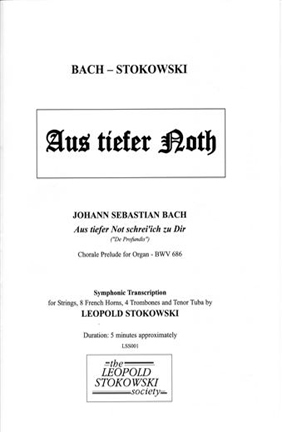
CESTI
Tu Mancavi a Tormentarmi (6’30")
Harp and Strings
–
HANDEL
Dead March from Saul (5’00")
–
MUSSORGSKY
Khovantchina Entr’acte (5’00")
–
NOVACEK
Perpetuum Mobile (7'00")
–
PALESTRINA
Adoramus Te (2’30")
–
SHOSTAKOVICH
Prelude in Eb minor (3’15")
–
Also: GABRIELI
In Ecclesiis
[Non-orchestral: for Choir, Brass Ensemble and Organ. Vocal score: rental only] (10’15")
(B) Published by Alexander Broude, Inc.,
New York (No longer active)
Agent Continuo/Kalmus
(Scores and parts for sale)
Edwin F. Kalmus & Co., Inc.
Music Publishers
P.O. Box 5011
Boca Raton, FL33431
Toll Free: 1-800-434-6340
Fax: (561) 241-6347
e-mail: efkalmus@aol.com
www.kalmus-music.com
Traditional
Slavic Christmas Music (for Brass and Strings) (2’50")
(attributed to Ippolitov-Ivanov as "In a Manger")
–
PABLO CASALS
O Vos Omnes (for Brass Ensemble) (3’00")
–
JOHN STAFFORD SMITH
The Star-Spangled Banner (1’30")
–
JOHN PHILIP SOUSA
The Stars and Stripes Forever (3’30")
(C) Reprinted by Edwin F. Kalmus
(contact information above)
(Scores and parts for sale or rental)
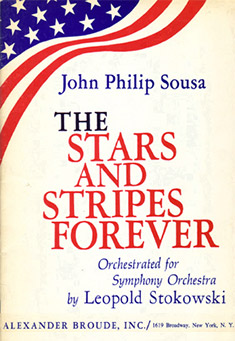
BACH
Adagio from Toccata, Adagio and Fugue in C
major (BWV 564) (4’30")
Aria (Air on the G string) from Suite No. 3 in D
(BWV 1068) (6’00") *
Ein’ feste Burg (after Luther) (6’00)
Komm süsser Tod (BWV 478) (5’00")
Mein Jesu (BWV 478) (5’00") *
Prelude in B minor (BWV 869) (4’00") *
Siciliano (BWV 1017) (2’50") *
Wir Glauben all’ an Einen Gott ("Giant
Fugue")(BWV 680) (3’50")
-
CESTI
Tu Mancavi a Tormentarmi (6’30") Harp and
Strings
–
FRANCK
Panis Angelicus (3'45")
(D) Published by Edition Peters
(C. F. Peters Corporation)
www.edition-peters.com/home.php
BACH
Sheep May Safely Graze (5’30")
(Scores and parts for Sale)
–
MUSSORGSKY
Pictures at an Exhibition (28’00")
(Scores for Sale; Parts on Rental)
The following have been professionally printed from the original handwritten manuscripts:
(E) By the Curtis Institute
but now in the Stokowski Collection, University of Pennsylvania
Rental Agent: Theodore Presser Company
(see below for details)
BORODIN
Requiem [for Orchestra, Male Chorus and Organ] (5’30")
(F) Published by Cala Music Publishing
17 Shakespeare Gardens
East Finchley
London N2 9LJ, UK
Phone 020-8883-7306
Fax 020-8335-7306
E-mail: paul@calarecords.com
BACH
Chaconne in D minor from
Solo Violin Partita No. 2 (BWV 1004) (16'30")
Preludio in E from
Solo Violin Partita No. 3 (BWV 1006) (3'30")
Aus tiefer Noth
Chorale Prelude (BWV 686) (4'30")
DEBUSSY
Night in Granada (6’15”)
MUSSORGSKY
Khovantchina Entr'acte (5'00")
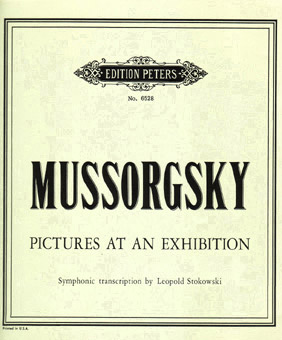
Note: All Unpublished Transcriptions
(ie: the hand-written manuscripts) which were formerly at the Curtis Institute of Music are now in the Stokowski Collection at the University of Pennsylvania.
The "Stokowski Collection" website there is:
www.library.upenn.edu/exhibits/rbm/stokowski
Inquiries and requests regarding Stokowski's manuscript and parts should go to:
Richard Griscom
Head, Otto E. Albrecht Music Library and
Eugene Ormandy Music and Media Center,
University of Pennsylvania, Van Pelt Library,
3420 Walnut Street, Philadelphia,
PA 19104-6206, USA
e-mail: griscom@pobox.upenn.edu
Office: 215-898-3450
Fax: 215-898-0559
As of January 2007, the Rental Agent for copies
of the Stokowski scores and parts is:
The Theodore Presser Company,
588 North Gulph Road,
King of Prussia, PA 19406, USA.
Phone: 610-592-1222
Fax: 610-592-1229
rental@presser.com
www.presser.com
A further detailed list of Stokowski Transcriptions can be found on Enno Riekena's Leopold Stokowski Site: see under Links.
Notes
A) The Alexander Broude music publishing company has been out of business for many years. The rights to their 4 Stokowski titles are owned by Tetra Music Corp. / Continuo Music Press, Inc.
For further details, contact the Agent:
Edwin F. Kalmus & Co., Inc
B) Sheetmusicplus lists many published
Stokowski Transcriptions on its website.
Stokowski Transcriptions
recorded by other conductors.
Many conductors have performed Stokowski's
Transcriptions since his death. Here is a list
of CDs devoted entirely to his arrangements,
starting with the 6 CDs made for Chandos by
Matthias Bamert and the BBC Philharmonic.
(1) Stokowski's Symphonic Bach
Toccata and Fugue in D minor; Air on the G
string; Little Fugue; Sheep May Safely Graze;
Prelude in B minor; Passacaglia and Fugue in
C minor; Siciliano; Mein Jesu; Easter Cantata
Chorale; Adagio in C; Komm susser Tod;
Wir glauben all' an Einen Gott (CHAN 9259)
(2) Stokowski Encores
Handel Overture in D minor; Gabrieli Sonata
Pian e Forte; Clarke Trumpet Prelude;
Mattheson Air; Mozart Turkish March;
Beethoven Moonlight Sonata Adagio;
Schubert Serenade; Franck Panis Angelicus;
Chopin Marche Funebre; Debussy The Girl
with the Flaxen Hair; Ippolitov-Ivanov
In the Manger; Shostakovich United Nations
March; Tchaikovsky Andante Cantabile;
Albeniz Festival in Seville; Sousa Stars and
Stripes Forever (CHAN 9349)
(3) Stokowski's Mussorgsky
A Night on Bare Mountain; Boris Godunov
Symphonic Synthesis; Entr'acte to Act IV
Khovanshchina; Pictures at an Exhibition
(CHAN 9445)
(4) Stokowski's Wagner
Wotan's Farewell and Magic Fire Music;
Tristan and Isolde Symphonic Synthesis;
Parsifal Symphonic Synthesis Act III
(CHAN 9686)
(5) Stokowski's Symphonic Baroque
Handel Water Music Suite; Buxtehude
Sarabande and Courante; Cesti Tu
Mancavi; Handel Dead March; Purcell
Suite; Victoria Jesus dulcis memoria;
Byrd Pavane and Gigue; Corelli Adagio;
Gluck Sicilienne; Vivaldi Concerto Grosso
(CHAN 9930)
(6) Stokowski's Symphonic Bach Vol. 2
Fantasia and Fugue in G minor; Arioso;
Wachet auf; Ein' feste Burg; Chaconne
in D minor; Andante sostenuto; Preludio
in E; Aus tiefer Noth; Jesu, Joy of Man's
Desiring; My Soul is Athirst; Sarabande;
Aus der Tiefe rufe ich; Fugue in C minor
(CHAN 10282)

In Stokowski's own handwriting, the manuscript of his arrangement of the "Moonlight Sonata" Adagio.
There is a similar on-going Stokowski
Transcriptions series on Naxos
in which Jose Serebrier conducts the
Bournemouth Symphony Orchestra:
(1) Mussorgsky-Stokowski
A Night on Bare Mountain; Entr'acte to
Act IV Khovanshchina; Boris Godunov
Symphonic Synthesis; Pictures at an
Exhibition; plus Tchaikovsky Humoresque
and Solitude; and Stokowski's version of
Traditional Slavic Christmas Music (also
attrib. Ippolitov-Ivanov as In a Manger)
(Naxos 8.557645)
(2) Bach-Stokowski
Air on the G string; Sheep May Safely
Graze; Little Fugue; Komm susser Tod;
Easter Cantata Chorale; Es ist vollbracht;
Wir glauben all' an einen Gott; Nun komm
der Heiden Heiland; Passacaglia and Fugue
in C minor; plus Handel Pastorale from
Messiah; Purcell Dido's Lament; and
Stokowski's version of Two Ancient
Liturgical Melodies (Naxos 8.557883)
(3) Wagner-Stokowski
Symphonic Syntheses
Tristan and Isolde; Parsifal;
Magic Fire Music; plus
The Ride of the Valkyries;
Entrance of the Gods into Valhalla
(Naxos 8.570293)
(4) Bach-Stokowski 2
Toccata and Fugue in D minor; Arioso;
Wachet auf; Ich ruf' zu dir, Herr Jesu Christ;
Adagio; Mein Jesu; Ein feste burg;
Jesu, Joy of Man's Desiring; Siciliano;
Prelude in B minor; Fugue in C minor;
plus Palestrina Adoramus Te;
Byrd Pavane and Gigue;
Clarke Trumpet Prelude;Boccherini Minuet;
Mattheson Air; Haydn Andante Cantabile
(Naxos 8.572050)
The above four Stokowski Transcriptions CDs
have been co-sponsored for Naxos by the
Leopold Stokowski Society


Other CD releases include the following:
Stokowski Transcriptions
Bach Sheep May Safely Graze; Wachet Auf;
Ein Feste Burg; Toccata and Fugue in D minor;
Boccherini Minuet; Beethoven Moonlight
Sonata Adagio; Chopin Prelude in E minor;
Franck Panis Angelicus; Tchaikovsky
Andante Cantabile and At the Ball; Debussy
Clair de lune and La Cathedrale Engloutie;
Rachmaninov Prelude in C sharp minor
Wolfgang Sawallisch and the
Philadelphia Orchestra
(EMI Classics 7243 5 55592 2 7)
Mussorgsky-Stokowski
Pictures at an Exhibition; Boris Godunov
Symphonic Synthesis; Entr'acte to Act IV
Khovanshchina; Night on Bare Mountain
Oliver Knussen and the Cleveland
Orchestra (DG 457 646-2)
Bach-Stokowski
Toccata and Fugue in D minor; Wachet auf;
Komm susser Tod; Passacaglia and Fugue
in C minor; Air on the G string; Chaconne
in D minor; Preludio in E; Arioso;
Ein Feste Burg
Jacques Grimbert and the Orchestre
de Paris-Sorbonne
(Arsis Classics AS-00-A-64004-C)
Bach-Stokowski
Toccata and Fugue in D minor; Adagio in C;
Little Fugue; Easter Cantata Chorale;
Passacaglia and Fugue in C minor; Komm
susser Tod; Wir glauben all' an einen Gott
Robert Pikler and the Sydney Symphony
Orchestra (Chandos CHAN 6532)
Stokowski Transcriptions
Mussorgsky Night on Bare Mountain
and Pictures at an Exhibition
Bach Toccata and Fugue in D minor
plus Bach-Webern Fuga (Ricercata)
James Sedares and the New Zealand
Symphony Orchestra (Koch
International Classics 3-7344-2H1)
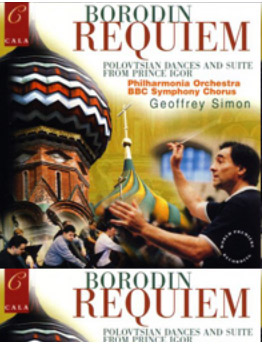
Cala Records have featured four Stokowski
Transcriptions in its releases, all conducted by
Geoffrey Simon:
Borodin Requiem; Debussy Night in Granada
& The Engulfed Cathedral;
Mussorgsky Khovantchina Entr'acte Act 4.
See the Cala Records website for full details:
www.calarecords.com
Stokowski Filmography
Compiled by Edward Johnson
1.
The Big Broadcast of 1937
(Paramount, 1936)
–
With Jack Benny, George Burns, Gracie Allen, Ray Milland and Leopold Stokowski and his Symphony Orchestra. Stokowski conducts his own transcriptions of Bach's Little Fugue in G Minor and Ein Feste Burg.
–
Directed by Mitchell Leisen.

Deanna Durbin and Stokowski in One Hundred Men and a Girl.
2.
One Hundred Men and a Girl
(Universal, 1937)
–
With Deanna Durbin, Adolphe Menjou, and Leopold Stokowski and his Symphony Orchestra. Music includes part of Tchaikovsky's 5th Symphony, Liszt's 2nd Hungarian Rhapsody, the Act 3 Prelude to Wagner's Lohengrin, and Mozart's Alleluia. Stokowski also plays Bach's Toccata and Fugue in D minor on the piano.
–
Directed by Henry Koster.
3.
Fantasia
(Walt Disney Productions / RKO, 1940)
–
Animated Cartoon Feature, with Bach's Toccata and Fugue in D minor, Tchaikovsky's Nutcracker Suite (excerpts), Dukas's The Sorcerer's Apprentice, Stravinsky's Rite of Spring (abridged), Beethoven's Pastoral Symphony(abridged), Ponchielli's Dance of the Hours, Mussorgsky's Night on Bald Mountain, and Schubert's Ave Maria. With Leopold Stokowski and the Philadelphia Orchestra.
–
Directed by Walt Disney.

4.
Carnegie Hall
(United Artists, 1947)
–
Musical artists include Artur Rubinstein, Jascha Heifetz, Gregor Piatigorsky, Lily Pons, Rise Stevens, Jan Peerce, and Ezio Pinza. With the New York Philharmonic conducted by Bruno Walter, Artur Rodzinski, Fritz Reiner, and Leopold Stokowski (in part of Tchaikovsky's 5th Symphony).
–
Directed by Edgar G. Ulmer.


